Enermax Galaxy DXX 1000W
Manufacturer: EnermaxPrice as reviewed (UK): £226.32 (inc. VAT)
Price as reviewed (US): $308 (ex. Tax)
The Enermax Galaxy DXX 1000W was the preferred choice of boutique PC maker, Vadim, when we looked at the Cepheus Q80 back in February. We also found its Infiniti 720W to be a fantastic performer in the previous group test we did in May.
As a company, Enermax has been specialising in PSUs for many years so it comes as no surprise that it knows exactly what kind of power supply is needed for its 1000W model.
The DXX means it's DirectX 10 compatible, which is a loose translation to indicate that it includes the new 8-pin power connector for ATI's Radeon HD 2900 XT and future PCI-Express 2.0 graphics cards. On Enermax's site the company offers both SLI and CrossFire capable PSUs separately but there's actually nothing between them and thus what we're reviewing here can be applied to both.
The box itself is a plain cardboard affair, although before picking it up you'll want to use your knees, save the inevitable hernia should you try otherwise. It has loads of information on virtually every side of the box, clearly stating what it contains and what it can power. You open it end on, rather than the usual flip top lid and when inside you're presented with two separate boxes: one for the PSU and the other for the cables and accessories. While it's no Tagan leather case, it can definitely still keep everything in order considering there's a plethora of additional equipment on top of the bubble wrapped PSU.
Accessories
- Enermax Lanyard;
- Two Enermax DXX stickers;
- Specification sheet and output diagram;
- Cable pouch;
- Additional modular cables;
- 8-pin 12V to 6+2-pin PCI-Express adapter;
- Black power lead.
If you know of someone who actually needs an Enermax lanyard, let us know. If you're the type to adorn your case with stickers, there's two Galaxy DXX ones thrown in, but the real usefulness comes from the cable pouch which keeps all your spare modular cables organised. Unfortunately no case cable management extras are included, like cable ties or Velcro straps, and they would have been far more useful here since the Enermax offers a ton of cabling.
The 8-pin 12V to 6+2-pin PCI-Express adapter is another great idea: this way one of the two 8-pin 12V connectors can be converted into another 6+2-pin PCI-Express cable for those running a many GPU system rather than specifically a server board.
The PSU itself is massive and even the large 13.5cm fan is dwarfed in the centre of the unit. It still fits within the ATX spec width and height, but without a doubt check your case can house the 22cm depth this unit uses. At 3.67kg this is one heavy puppy and should not be installed off the ground without an additional bracket to take the weight. We'd suggest that it be mounted at the bottom of a case.
Its blue paint job has both Enermax embossed, on the same side as the large fan, and a large white Galaxy branding on the sides. On the back there are two red 6-pin PCI-Express sockets and six black 5-pin sockets for everything else. The sockets don't sit flush with the actual unit and aren't the best best looking modular connectors we've seen but they're certainly sturdily built and relatively easy to plug/unplug.
The exhaust fan is a much smaller and more normal 80x80x25mm. At the back there's an industrial sized illuminated power button, status LED and reset button in addition to the inevitable power socket. The status LED and reset button are part of Enermax's PowerGuard system which, combined with an internal speaker alerts the user to problems like a fan failure or overvoltage protection. It's a great initiative, especially if you're going to have a lot of expensive kit connected to it which you don't want getting broken should the PSU go bad.

MSI MPG Velox 100R Chassis Review
October 14 2021 | 15:04


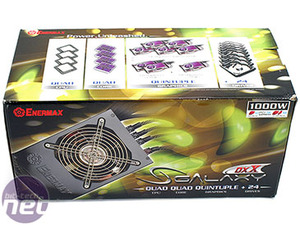
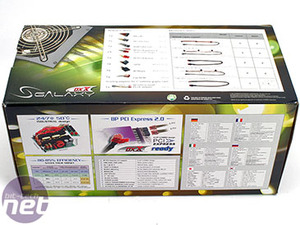
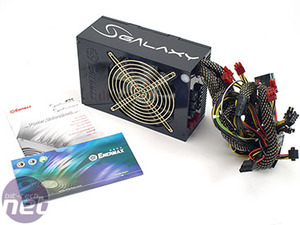
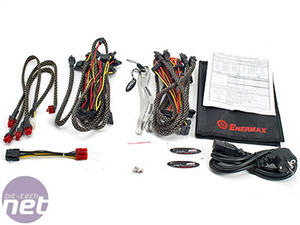
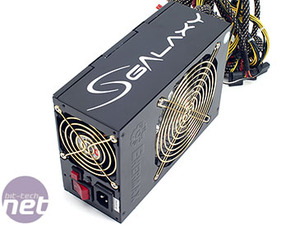
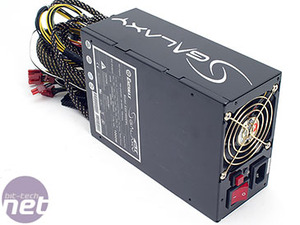
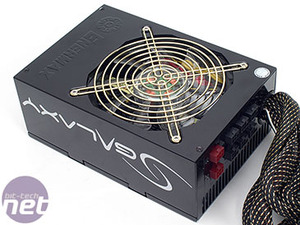








Want to comment? Please log in.